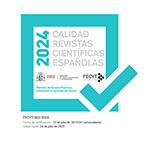"Mother not quite in her right mind?": Rewriting the castrating mother in the audiovisual fiction Bates Motel, the contemporary prequel to Psycho
Abstract
Introduction and objectives. The evolution of the character of Norma Bates, the mother of the murderer Norman in Psycho, is studied in various audiovisual works with the aim of observing the changes in the description of the maternal figure and its link with the son’s psychopathology and criminal behaviour. It is intended to show how the representation of her collects the trends around motherhood and upbringing of each era. Methodology. In order to contemplate the evolution of the maternal character in works derived from the novel Psycho (Bloch, 1959), a textual analysis of this work, of the film Psycho (Hitchcock, 1960), the subsequent film and television adaptations during the 80’s and the fiction series Bates Motel (A&E, 2013-2017). Results. In the first film, the mother figure is shown passively and is the one to blame for Norman's criminality. The sequels follow the same pattern. In contrast, in the prequel Bates Motel (A&E, 2013-2017) the mother is a protagonist and Norma’s upbringing alone is not to blame for Norman’s behavior. Discussion. This television series rewrites the character of Norma, modifying her role as a castrator mother. Likewise, the character of Marion Crane, who was the victim in the novel and the film, has in this series a different destiny, so the representation of the two secondary female figures in the original story is more progressive and incorporates a rereading of the work more akin to the current social context, although it doesn’t get over some postfeminist stereotypes.
Downloads
Article download
License
In order to support the global exchange of knowledge, the journal Investigaciones Feministas is allowing unrestricted access to its content as from its publication in this electronic edition, and as such it is an open-access journal. The originals published in this journal are the property of the Complutense University of Madrid and any reproduction thereof in full or in part must cite the source. All content is distributed under a Creative Commons Attribution 4.0 use and distribution licence (CC BY 4.0). This circumstance must be expressly stated in these terms where necessary. You can view the summary and the complete legal text of the licence.











